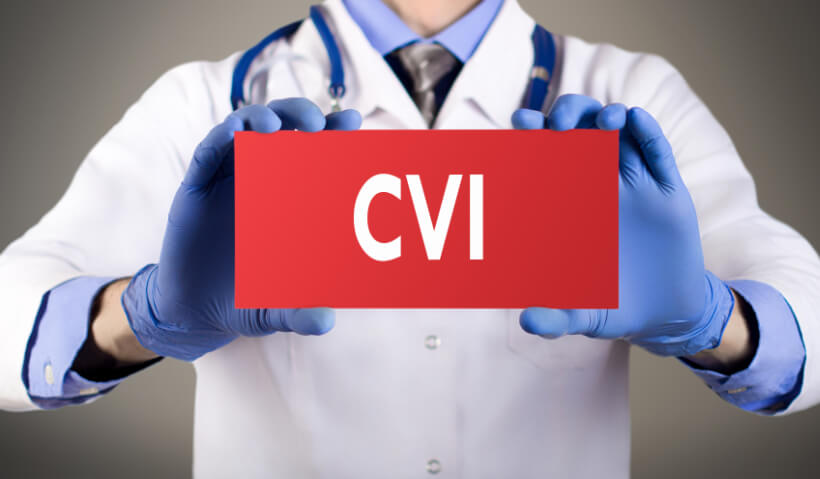

What Are the Stages of Chronic Venous Insufficiency?

Chronic venous insufficiency (CVI) is a long-term vein condition that worsens over time. Doctors measure the progression of CVI in stages. Each stage of the condition can cause different signs and symptoms; treatment for CVI can vary according to its stage.
CVI is a condition that affects the veins of the legs. Arteries carry oxygen-rich blood from the heart to the rest of the body. As the cells of the body use the oxygen, they create toxins, and send these toxins back to the bloodstream. Veins carry these toxins and oxygen-poor blood from the cells back up to the heart. Gravity helps blood flow downward through arteries to the feet; gravity fights against the veins as they carry blood back up to the heart.
In cases of CVI, the veins do an inadequate job of moving blood – and the toxins it carries – back up to the heart. Instead, blood tends to pool in the veins in the lower legs. This pooling causes the veins to bulge and swell; it also prevents the body from carrying toxins away from cells and tissues of the lower legs. In time, the lack of circulation and exposure to the toxins in the blood begin to break down the skin tissue in the lower legs. In the later stages of CVI, the breakdown of skin tissue causes significant changes that require medical treatment.
Chronic venous insufficiency causes specific signs and symptoms. Symptoms are those things that the patient can feel and experience, such as pain or itching. Signs are those things that a doctor notices, such as the appearance of varicose veins and spider veins. Doctors classify chronic venous insufficiency according to these signs and symptoms.
6 Stages of Chronic Venous Insufficiency
C0
There are no visible signs of CVI during the first stage, known as stage C0. Doctors typically recommend lifestyle changes, such as a healthy diet and increased exercise to lose weight, as weight loss can help slow the progression of CVI.
C1
Signs of CVI begin to appear in stage C1, as small blood vessels begin to expand enough to become visible. These small blue or purple veins, known as reticular veins, are between 1 and 3 millimeters (mm). Tiny red spider veins, also known as telangiectasias veins, may also appear.
Doctors recommend lifestyle changes and sometimes suggest patients start wearing compression garments, such as compression stockings, to help squeeze blood up and out of the lower legs,
C2
Varicose veins begin to appear during stage C2. Varicose veins are enlarged enough to feel them protruding under the skin. Treatment includes compression garments and exercise. Varicose vein treatment may help; these treatments involve scarring the vein to cause its collapse.
In some cases, varicose veins continue to come back after treatment. Doctors refer to this as C2r, a sub-stage of C2.
C3
Stage C3 involves edema, or swelling in the legs that result from accumulating fluids in the tissues. Skin looks healthy and normal. Treatment for this stage of chronic venous insufficiency includes
C4
Stage C4 involves skin changes along with edema. Medical professionals break C4 into three sub-stages:
- C4a – surface changes to skin include red and itchy skin; small brown or gray spots may appear
- C4b – involves more drastic and sometimes painful skin changes; skin can change textures, thicken or harden in places, and scars may appear on the lower legs
- C4c – visible veins and blood vessels appear around the ankles in a condition known as corona phlebectatica; treatment involves skin care to treat these changes, along with continued treatment for edema and varicose veins
C5 – open wounds, known as ulcers, appear on the skin, but can heal in time; treatment focuses on reducing edema and varicose veins to prevent the development of more ulcers
C6 – features open wounds that require wound care, such as medicated creams and special dressings, to heal
Stage C6 has a sub-stage, known as C6r, in which ulcers return despite treatment.
A and B classifications
Medical professionals may also give an A or B classification to each C stage. A classification means you are experiencing signs but not symptoms, whereas a B classification means there are both signs and symptoms. For example, if your legs are swollen but you are not experiencing pain, your doctor may classify it as stage C3A. If you have pain and swelling in your legs, your doctor might classify it as stage C3B.
For more information about the stages of chronic venous insufficiency, consult with your doctor or healthcare professional. Identifying CVI at an early stage can help you receive the treatment you need to stop the progression of this vein disease before it can cause serious problems.





